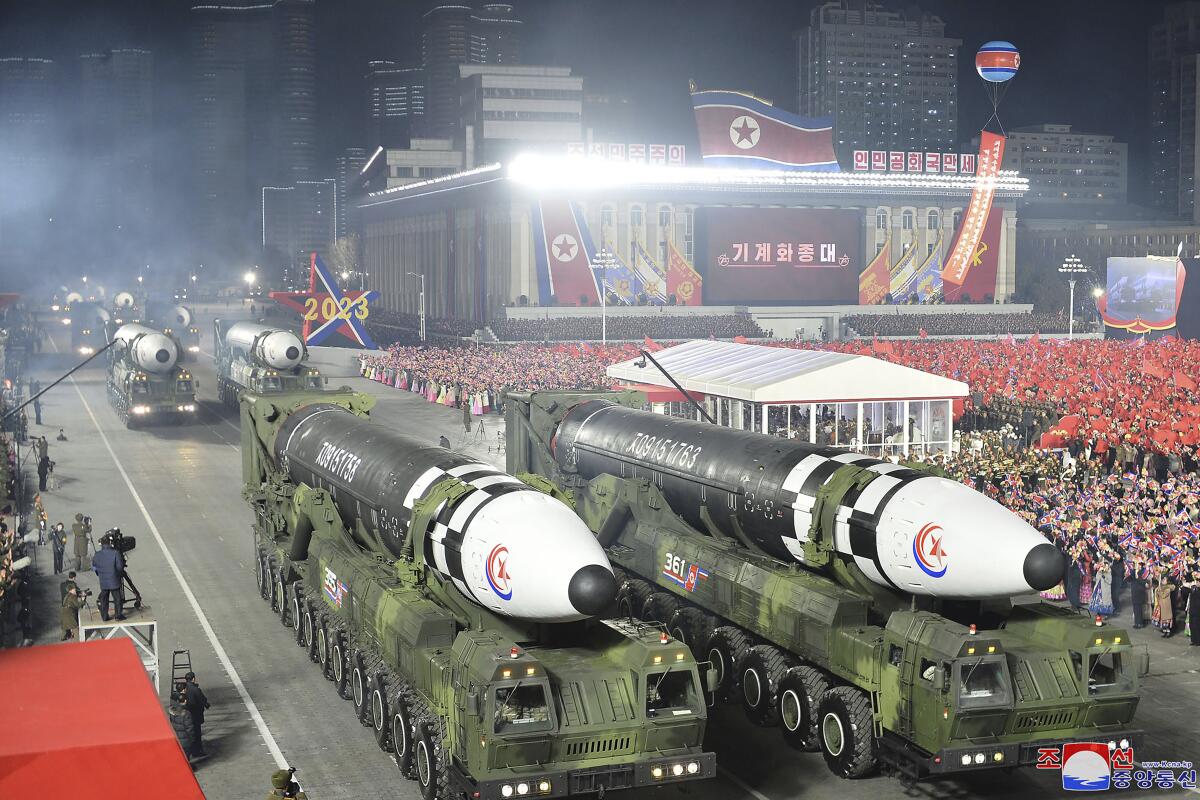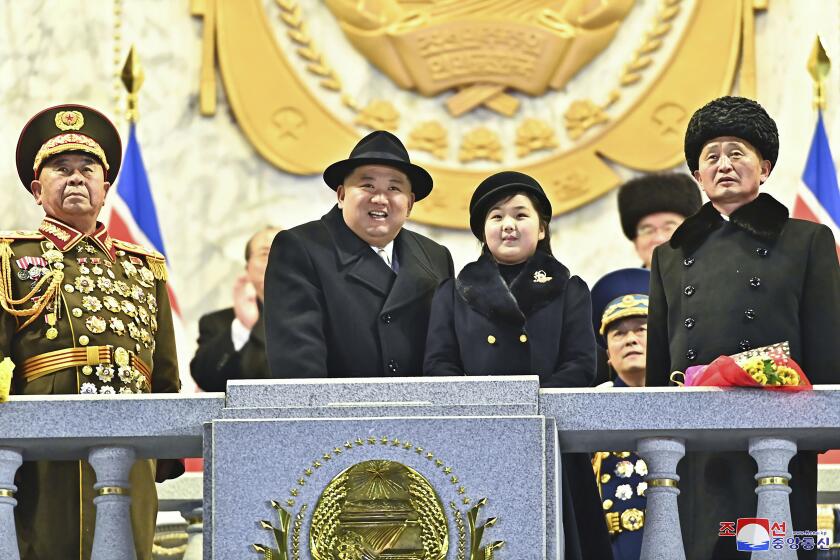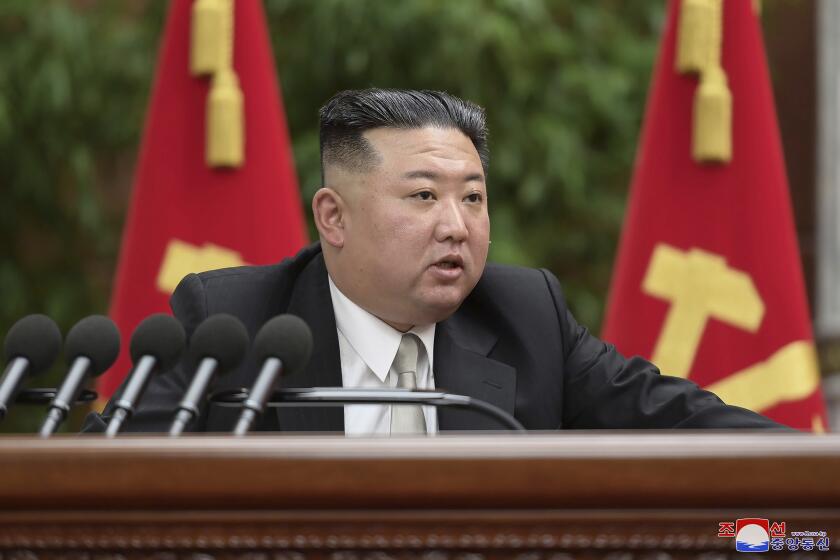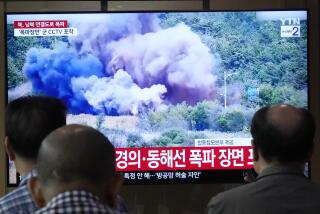North Korea fires missile as U.S. and South Korea prepare for drills

SEOUL — North Korea on Saturday fired a long-range missile from its capital into the sea off Japan, according to its neighbors, a day after it threatened to take strong measures against South Korea and the U.S. over their joint military exercises.
According to the South Korean and Japanese militaries, the test missile was fired on a high angle, apparently to avoid reaching the neighbors’ territories, and traveled about 560 miles at a maximum altitude of 3,500 miles during an hourlong flight.
The details were similar to North Korea’s Hwasong-17 intercontinental ballistic missile test flight in November, which experts said demonstrated potential to reach the U.S. mainland if fired on a normal trajectory.
Japanese government spokesperson Hirokazu Matsuno said no damage was reported from the missile, which landed within Japan’s exclusive economic zone, about 125 miles west of Oshima island. Oshima lies off the western coast of the northernmost main island of Hokkaido.
North Korea’s Foreign Ministry on Friday threatened “unprecedently” strong action against its rivals, after South Korea announced a series of military exercises with the United States aimed at sharpening their potential response amid the North’s growing threats.
While the U.S. Indo-Pacific Command said the launch did not pose an immediate threat to U.S. personnel, territory or its allies, the White House National Security Council said it needlessly raises tensions and risks destabilizing the security situation in the region.
“It only demonstrates that the DPRK continues to prioritize its unlawful weapons of mass destruction and ballistic missile programs over the well-being of its people,” it said, referring to North Korea by its formal name, the Democratic People’s Republic of Korea, and calling the launch a “flagrant violation of multiple U.N. Security Council resolutions.”
The office of South Korean President Yoon Suk-yeol said his national security director, Kim Sung-han, presided over an emergency security meeting that accused the North of escalating regional tensions. It denounced the government in Pyongyang for accelerating its nuclear arms development despite signs of worsening economic problems and food insecurity, saying such actions would bring only tougher international sanctions.
Japanese Prime Minister Fumio Kishida said his government was closely communicating with Washington and Seoul over the launch, which he called “an act of violence that escalates provocation toward the international order.”
The launch was North Korea’s first known testing activity since Jan. 1, when it test-fired a short-range weapon. It followed a massive military parade in Pyongyang last week where troops rolled out more than a dozen intercontinental ballistic missiles as leader Kim Jong Un watched from a balcony.
The unprecedented number of missiles underscored a continuation of expansion of his country’s military capabilities despite limited resources while negotiations with Washington remain stalemated.
Those missiles included a new system experts say is possibly linked to North Korea’s stated desire to acquire a solid-fuel ICBM. North Korea’s existing ICBMs, including Hwasong-17s, use liquid propellants that require prelaunch injections and cannot remain fueled for prolonged periods. A solid-fuel alternative would take less time to prepare and is easier to move around on vehicles, providing less opportunity to be spotted.
It wasn’t immediately clear whether Saturday’s launch involved a solid-fuel system.
North Korea is coming off a record year in weapons demonstrations with more than 70 ballistic missiles fired, including ICBMs with potential range to reach the U.S. mainland. Pyongyang also conducted a slew of launches it described as simulated nuclear attacks against South Korean and U.S. targets in response to the allies’ resumption of large-scale joint military exercises that had been downsized for years.
North Korea’s missile tests have been punctuated by threats of preemptive nuclear attacks against South Korea or the United States over what it perceives as a broad range of scenarios that put its leadership under threat.
North Korean dictator Kim Jong Un’s appearance at a military parade with his daughter, Kim Ju Ae, fueled speculation that she is being groomed as a future leader.
Kim accelerated his nuclear push entering 2023, calling for an “exponential increase” in the country’s nuclear warheads, mass production of battlefield tactical nuclear weapons targeting “enemy” South Korea and the development of more advanced ICBMs.
The North Korean statement Friday said Washington and Seoul were planning more than 20 rounds of military drills this year, including large-scale field exercises, and described its rivals as “the arch-criminals deliberately disrupting regional peace and stability.”
The statement came hours after South Korea’s Defense Ministry officials told lawmakers that Seoul and Washington will hold an annual computer-simulated combined training in mid-March. The 11-day training would reflect North Korea’s nuclear threats, as well as unspecified lessons from the Russia-Ukraine war, according to Heo Tae-keun, South Korea’s deputy minister of national defense policy.
Heo said the two countries will also conduct joint field exercises in mid-March that would be bigger than those held in the last few years.
South Korea and the U.S. will also hold a one-day tabletop exercise next week at the Pentagon to sharpen a response to a potential use of nuclear weapons by North Korea.
North Korean leader Kim Jong Un presents new plans to bolster military power, in an indication he’ll continue his provocative run of weapons displays.
The exercise, scheduled for Wednesday, would set up possible scenarios where North Korea uses nuclear weapons, explore how to cope with them militarily and formulate crisis management plans, South Korea’s Defense Ministry said.
North Korea has traditionally described U.S.-South Korea military exercises as rehearsals for a potential invasion, while the allies describe their drills as defensive in nature.
Associated Press writer Yuri Kageyama in Tokyo contributed to the report.
More to Read
Sign up for Essential California
The most important California stories and recommendations in your inbox every morning.
You may occasionally receive promotional content from the Los Angeles Times.












